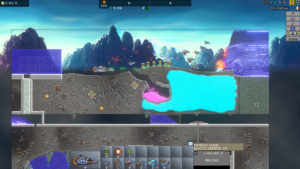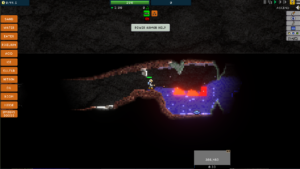Creeper World Ixe
Speaking of titles that I played obsessively for a time, 2024 also saw the release of a new Creeper World game! But it occurs to me that I never posted about Creeper World IV here, so let’s talk a little about that first. Creeper World IV was the franchise’s foray into 3D, and it was fine. If you’re a fan of Creeper World, and you’ve wondered what it would be like with 3D models, it’s worth a look. But it’s nothing to write home about, especially after Creeper World 3: Arc Eternal, which is, to my mind, still the ultimate and definitive Creeper World experience. Being 3D adds the possibility of a first-person mode, and, while this wasn’t used in any of the campaign mission, it’s telling that basically all of the top-rated player-made levels use it. It’s like the fanbase decided it was more fun to use the engine to play a different game.
 Now, the new one: Creeper World Ixe. (Or, according to some of the title graphics, Ixe Creeper World. “Ixe” is the name of an alien race in the game’s backstory, which I will not be describing any more than that.) This game abandons the 3D and in fact brings us back to the vertical 2D view that we haven’t seen since Creeper World 2, based on cave systems that constrain and pressurize your fluid enemy. But the game isn’t just Creeper World 2 brought up to modern standards. It’s Creeper World 2 hybridized with Noita.
Now, the new one: Creeper World Ixe. (Or, according to some of the title graphics, Ixe Creeper World. “Ixe” is the name of an alien race in the game’s backstory, which I will not be describing any more than that.) This game abandons the 3D and in fact brings us back to the vertical 2D view that we haven’t seen since Creeper World 2, based on cave systems that constrain and pressurize your fluid enemy. But the game isn’t just Creeper World 2 brought up to modern standards. It’s Creeper World 2 hybridized with Noita.
This might seem strange. The Creeper World games are real-time strategy games in a sci-fi milieu, and Noita is a fantasy Roguelike. But they both have a lot to do with simulating fluids, and the main thing Ixe gets from Noita is its pixel-level simulation. CW2, in contrast, was fundamentally tile-based. The world was a grid where everything you could build occupied one square and the Creeper was essentially a cellular automaton. The pixelation of Ixe is notably coarse, but not tile-level coarse.
And the pixelation doesn’t just affect fluids. As in Particle Fleet by the same developers, your own ships take damage by having pixels eaten away. This isn’t the only thing it takes from Particle Fleet, either: some levels feature a similar particulate enemy, and, as in PF, the number of ships of any type you can have at a time is limited, making for smaller-scale battles. The very fact that I refer to your units as “ships” is a symptom of how Particle-Fleet-ish it is; Creeper World is usually about land battles. But the pixel-level simulation is stronger and weirder here: when you move your ships, they move by physically breaking apart into the pixels they were built from, which form a sort of snake-like chain, slithering its way around walls to reach its destination and reform.
But back to the fluids. In addition to Creeper and Anti-Creeper, there are several other fluids found in the environment, as well as substances with “sand physics”, pixels that form heaps when they fall. And some of them are useful: oil, sulfur, pixellium, etc. These can be sucked up and combined into other useful substances, like explosives or acid. And, as in Noita, you combine them by throwing them into a pit together. This is the single thing that makes me certain that Noita was a direct influence, rather than just something that hit on similar ideas independently. The system of alchemy here isn’t nearly as complex as Noita‘s, but I’ve seen player-made levels that extend it with secret combinations and new substances.
 In the campaign’s final level, it makes a final turn towards Noita by stopping being a RTS and instead becoming a 2D metroidvania, with a single player character running around a complex, shooting at Creeper, picking up keycards, and mixing chemicals in vats. I feel like this might be a reaction to all the first-person levels made for CW4, a way to get ahead of the inevitable genre shift among the fans, to make it planned and deliberate. But I haven’t seen any player-made levels like it yet.
In the campaign’s final level, it makes a final turn towards Noita by stopping being a RTS and instead becoming a 2D metroidvania, with a single player character running around a complex, shooting at Creeper, picking up keycards, and mixing chemicals in vats. I feel like this might be a reaction to all the first-person levels made for CW4, a way to get ahead of the inevitable genre shift among the fans, to make it planned and deliberate. But I haven’t seen any player-made levels like it yet.
I’ll say it again: Creeper World 3 is the definitive Creeper World. This game isn’t even trying to be the Next Big Development of the series. It’s the quirky offshoot of the series, an experiment in what else you can do with the basic idea. And I kind of love it for that.
 Comments(0)
Comments(0)